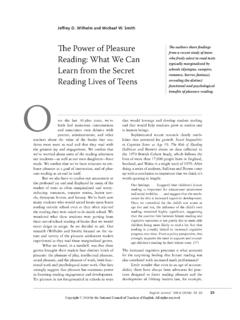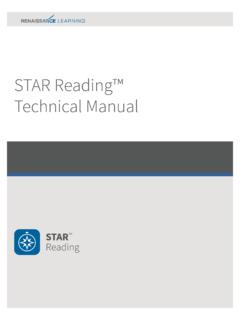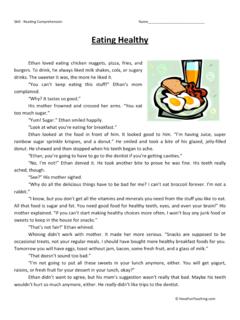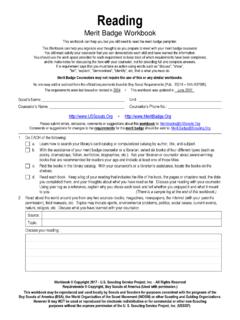Transcription of English Language Arts and Reading 4-8 (117) Preparation …
1 Texas Examinations of Educator Standards . (TExES ) Program Preparation Manual English Language Arts and Reading 4 8 (117). Copyright 2018 by Texas Education Agency (TEA). All rights reserved. The Texas Education Agency logo and TEA are registered trademarks of Texas Education Agency. Texas Examinations of Educator Standards, TExES and the TExES. logo are trademarks of Texas Education Agency. The Texas Education Agency and Pearson do not discriminate on the basis of race, color, national origin, sex, religion, age, or disability in the administration of the testing program or the provision of related services. Table of Contents About The Test .. 3. The 4. The Standards .. 4. Domains and Competencies .. 6. Domain I Language Arts, Part I: Oral Language , Early Literacy Development, Word Identification Skills and Reading Fluency.
2 6. Domain II Language Arts, Part II: Reading Comprehension and Assessment, Reading Applications, Written Language , Viewing and Representing and Study and Inquiry 10. Approaches to Answering Multiple-Choice Questions .. 17. Question Formats .. 17. Single Questions .. 18. Clustered Questions .. 19. Multiple-Choice Practice Questions .. 24. Answer Key and Rationales .. 47. Study Plan Sheet .. 65. Preparation Resources .. 66. NOTE: After clicking on a link, right click and select Previous View to go back to original text. TExES English Language Arts and Reading 4 8 (117) 2. About The Test Test Name English Language Arts and Reading 4 8. Test Code 117. Time 5 hours Number of Questions 100 multiple-choice questions Format Computer-administered test (CAT). The TExES English Language Arts and Reading 4 8 (117) test is designed to assess whether a test taker has the requisite knowledge and skills that an entry-level educator in this field in Texas public schools must possess.
3 The 100 multiple-choice questions are based on the English Language Arts and Reading 4 8 test framework. Questions on this test range from grades 4 8. The test may contain questions that do not count toward the score. Your final scaled score will be based only on scored questions. NOTE: After clicking on a link, right click and select Previous View to go back to original text. TExES English Language Arts and Reading 4 8 (117) 3. The Domains Approx. Percentage Domain Domain Title of Test Standards Assessed Language Arts, Part I: Oral Language , Early Literacy English Language I. Development, Word 33% Arts and Reading 4 8. Identification Skills and I III, VIII. Reading Fluency Language Arts, Part II: Reading Comprehension and Assessment, Reading English Language II. Applications, Written 67% Arts and Reading 4 8.
4 Language , Viewing and IV VIII. Representing and Study and Inquiry Skills The Standards English Language Arts and Reading 4 8 Standard I. Oral Language : Teachers of students in grades 4 8 understand the importance of oral Language , know the developmental processes of oral Language and provide a variety of instructional opportunities for students to develop listening and speaking skills. English Language Arts and Reading 4 8 Standard II. Foundations of Reading : Teachers of students in grades 4 8 understand the foundations of Reading and early literacy development. English Language Arts and Reading 4 8 Standard III. Word Analysis Skills and Reading Fluency: Teachers understand the importance of word analysis skills (including decoding, blending, structural analysis, sight word vocabulary) and Reading fluency and provide many opportunities for students to practice and improve their word analysis skills and Reading fluency.
5 English Language Arts and Reading 4 8 Standard IV. Reading Comprehension: Teachers understand the importance of Reading for understanding, know the components of comprehension and teach students strategies for improving their comprehension. NOTE: After clicking on a link, right click and select Previous View to go back to original text. TExES English Language Arts and Reading 4 8 (117) 4. English Language Arts and Reading 4 8 Standard V. Written Language : Teachers understand that writing is a developmental process and provide instruction that helps students develop competence in written communication. English Language Arts and Reading 4 8 Standard VI. Study and Inquiry Skills: Teachers understand the importance of study and inquiry skills as tools for learning and promote students' development in applying study and inquiry skills.
6 English Language Arts and Reading 4 8 Standard VII. Viewing and Representing: Teachers understand how to interpret, analyze, evaluate and produce visual images and messages in various media and to provide students with opportunities to develop skills in this area. English Language Arts and Reading 4 8 Standard VIII. Assessment of Developing Literacy: Teachers understand the basic principles of assessment and use a variety of literacy assessment practices to plan and implement instruction. NOTE: After clicking on a link, right click and select Previous View to go back to original text. TExES English Language Arts and Reading 4 8 (117) 5. Domains and Competencies The content covered by this test is organized into broad areas of content called domains. Each domain covers one or more of the educator standards for this field.
7 Within each domain, the content is further defined by a set of competencies. Each competency is composed of two major parts: The competency statement, which broadly defines what an entry-level educator in this field in Texas public schools should know and be able to do. The descriptive statements, which describe in greater detail the knowledge and skills eligible for testing. Domain I Language Arts, Part I: Oral Language , Early Literacy Development, Word Identification Skills and Reading Fluency Competency 001 (Oral Language ): The teacher understands the importance of oral Language , knows the developmental processes of oral Language and provides a variety of instructional opportunities for students to develop listening and speaking skills. The beginning teacher: A. Knows basic linguistic concepts ( , phonemes, segmentation) and developmental stages in acquiring oral Language , including stages in phonology, semantics, syntax and pragmatics and recognizes that individual variations occur.
8 B. Knows characteristics and uses of informal and formal oral Language assessments and uses multiple, ongoing assessments to monitor and evaluate students' oral Language skills. C. Provides Language instruction that acknowledges students' current oral Language skills and that builds on these skills to increase students' oral Language proficiency. D. Plans, implements and adapts instruction that is based on informal and formal assessment of students' progress in oral Language development and that addresses the needs, strengths and interests of individual students, including English - Language learners. E. Recognizes when oral Language delays or differences warrant in-depth evaluation and additional help or intervention. F. Knows how to provide explicit, systematic oral Language instruction and supports students' learning and use of oral Language through meaningful and purposeful activities implemented one-to-one and in a group.
9 NOTE: After clicking on a link, right click and select Previous View to go back to original text. TExES English Language Arts and Reading 4 8 (117) 6. G. Selects and uses instructional materials and strategies that promote students' oral Language development; that respond to students' individual strengths, needs and interests; that reflect cultural diversity; and that build on students' cultural, linguistic and home backgrounds to enhance their oral Language development. H. Understands relationships between the development of oral Language and the development of Reading and provides instruction that interrelates oral and written Language to promote students' Reading proficiency and learning ( , preview-review, discussion, questioning). I. Knows similarities and differences between oral and written Language and how to promote students' awareness of these similarities and differences.
10 J. Selects and uses instructional strategies, materials, activities and models to strengthen students' oral vocabulary and narrative skills in spoken Language and teaches students to connect spoken and printed Language . K. Selects and uses instructional strategies, materials, activities and models to teach students skills for speaking to different audiences for various purposes and for adapting spoken Language for various audiences, purposes and occasions. L. Selects and uses instructional strategies, materials, activities and models to teach students listening skills for various purposes ( , critical listening to evaluate a speaker's message, listening to enjoy and appreciate spoken Language ) and provides students with opportunities to engage in active, purposeful listening in a variety of contexts. M. Selects and uses instructional strategies, materials, activities and models to teach students to evaluate the content and effectiveness of their own spoken messages and the messages of others.













